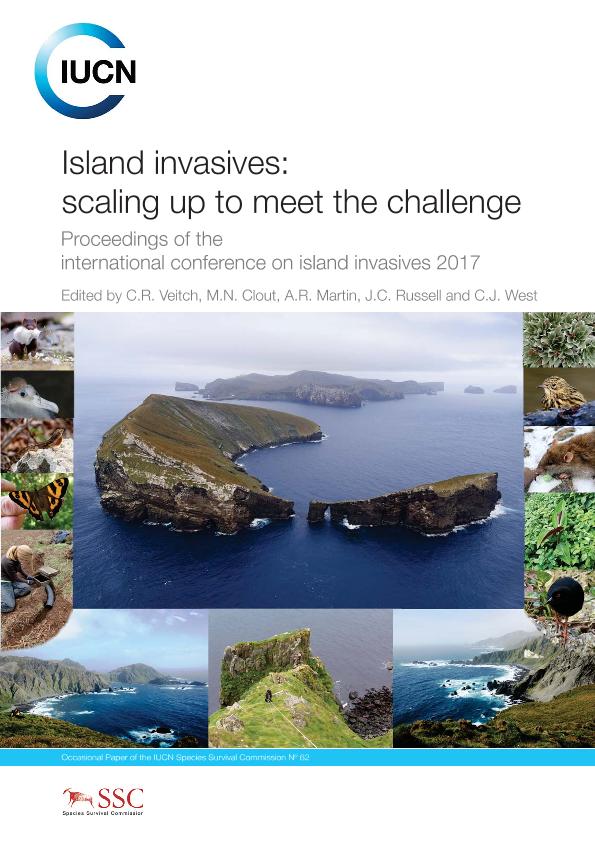Mostrar el registro sencillo del ítem
dc.contributor.author
Schiavini, Adrian Carlos Miguel

dc.contributor.author
Escobar, Julio Martin

dc.contributor.author
Curto, Erio
dc.contributor.author
Jusim, Pablo Matías

dc.date.available
2023-04-21T15:43:01Z
dc.date.issued
2019
dc.identifier.citation
First results from a pilot programme for the eradication of beavers for environmental restoration in Tierra Del Fuego; International conference on island invasives; Dundee; Reino Unido; 2017; 57-63
dc.identifier.isbn
978-2-8317-1961-0
dc.identifier.uri
http://hdl.handle.net/11336/194940
dc.description.abstract
A pilot project for the eradication of beavers (Castor canadensis) in Tierra del Fuego started as part of a binational agreement, signed between Argentina and Chile, to restore the affected environments. The project covers nine pilot areas of different landscapes and land tenures in the Argentinian part of Isla Grande de Tierra del Fuego. We report on the results from operations in the first of the pilot areas. From October 2016 to January 2017, ten trappers (named restorers for advocacy purposes) used body-grip traps, snares and an air rifle, in a first phase, which included 2,237 trapping nights and 1,168 trap-sets. Shooting efforts were not monitored. Traps were set for 1,401 trapping-nights and caught 175 beavers at a success rate of 12.5% (captures per trap night). Snares were set for 936 snare-nights and caught 22 beavers at a success rate of 2.3%. Seven beavers were shot. Most beavers (65%) were removed during the first week of trapping in the different watercourse sections. Stopping trapping for a week or more did not increase efficiency. From March to May 2017 restorers removed 24 survivors and/or reinvaders, including 10 from two previously untrapped colonies. Capture efficiency for this removal period was low for body-gripping traps but not for snares. The sex ratio of catches was 47% females to 53% males. The age structure of catches was 15% kits, 29% yearlings, 51% adults, with 4% not aged. An estimated total of 41 colonies was trapped, giving an average of 5.6 animals per colony. After nominal eradication was declared by restorers, 154 camera trapping nights were deployed to assess eradication success. Nine cameras (of 26 cameras used) detected beavers. Therefore, eradication was not achieved using the methods and efforts in the first part of the pilot study. This highlights the need for more effort or the application of different techniques or trapping strategies. For example, daily checking of traps may cause the animals to be cautious so, the next step in the programme will involve exploring alternative trapping methods to reduce disturbance.
dc.format
application/pdf
dc.language.iso
eng
dc.publisher
Unión Internacional para la Conservación de la Naturaleza
dc.rights
info:eu-repo/semantics/openAccess
dc.rights.uri
https://creativecommons.org/licenses/by-nc-sa/2.5/ar/
dc.subject
Argentina
dc.subject
Castor canadensis
dc.subject
eradication programme
dc.subject
management
dc.subject.classification
Conservación de la Biodiversidad

dc.subject.classification
Ciencias Biológicas

dc.subject.classification
CIENCIAS NATURALES Y EXACTAS

dc.title
First results from a pilot programme for the eradication of beavers for environmental restoration in Tierra Del Fuego
dc.type
info:eu-repo/semantics/publishedVersion
dc.type
info:eu-repo/semantics/conferenceObject
dc.type
info:ar-repo/semantics/documento de conferencia
dc.date.updated
2023-02-27T16:06:02Z
dc.journal.number
62
dc.journal.pagination
57-63
dc.journal.pais
Suiza

dc.journal.ciudad
Gland
dc.description.fil
Fil: Schiavini, Adrian Carlos Miguel. Wildlife Conservation Society; Estados Unidos. Universidad Nacional de Tierra del Fuego; Argentina. Consejo Nacional de Investigaciones Científicas y Técnicas. Centro Austral de Investigaciones Científicas; Argentina
dc.description.fil
Fil: Escobar, Julio Martin. Consejo Nacional de Investigaciones Científicas y Técnicas. Centro Austral de Investigaciones Científicas; Argentina
dc.description.fil
Fil: Curto, Erio. Dirección General de Áreas Protegidas y Biodiversidad; Argentina
dc.description.fil
Fil: Jusim, Pablo Matías. Universidad Nacional de Tierra del Fuego; Argentina. Universidad de Buenos Aires. Facultad de Ciencias Exactas y Naturales; Argentina. Consejo Nacional de Investigaciones Científicas y Técnicas. Centro Austral de Investigaciones Científicas; Argentina
dc.relation.alternativeid
info:eu-repo/semantics/altIdentifier/url/https://doi.org/10.2305/IUCN.CH.2019.SSC-OP.62.en
dc.relation.alternativeid
info:eu-repo/semantics/altIdentifier/url/https://portals.iucn.org/library/node/48358
dc.conicet.rol
Autor

dc.conicet.rol
Autor

dc.conicet.rol
Autor

dc.conicet.rol
Autor

dc.conicet.nroedicion
XIV
dc.coverage
Internacional
dc.type.subtype
Congreso
dc.description.nombreEvento
International conference on island invasives
dc.date.evento
2017-07-10
dc.description.ciudadEvento
Dundee
dc.description.paisEvento
Reino Unido

dc.type.publicacion
Book
dc.description.institucionOrganizadora
Unión Internacional para la Conservación de la Naturaleza
dc.source.libro
Island invasives: scaling up to meet the challenge. Proceedings of the international conference on island invasives 2017
dc.date.eventoHasta
2017-07-14
dc.type
Congreso
Archivos asociados
